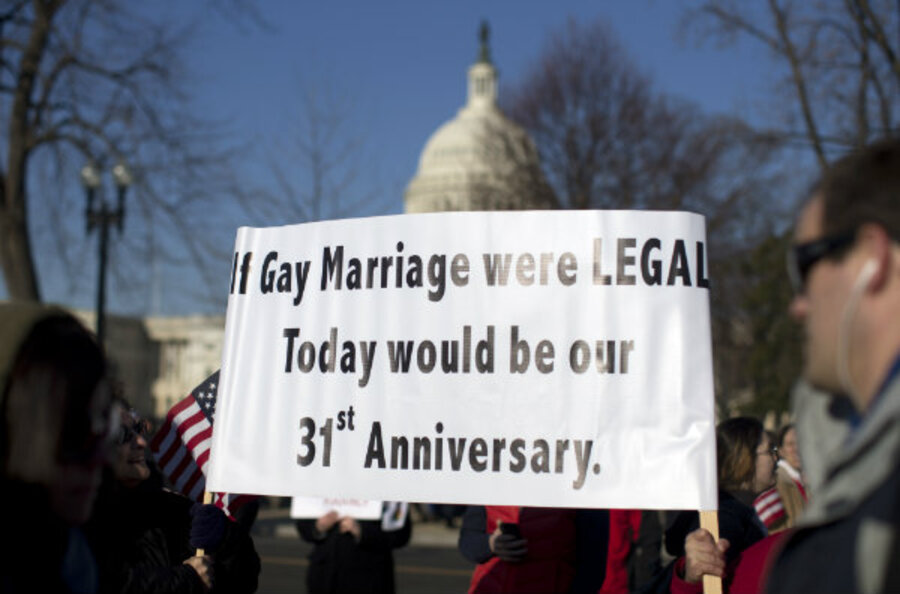Why Supreme Court's gay marriage ruling won't be like Roe v. Wade
Loading...
| Atlanta
The day of legal reckoning on two US Supreme Court cases concerning gay marriage may soon be here. The tedious four-month stretch between oral arguments and court decisions has conditioned court observers to parse even the faintest overtures from the high court for some sign of how the justices may rule – each side in the debate desperate for some indication their opponents might falter.
The desperate-for-clues dynamic has lent itself to the proliferation of some silly arguments. One example of such an argument is what same-sex marriage opponents proffered when liberal Justice Ruth Bader Ginsburg expanded her earlier criticism of the landmark 1973 Roe v. Wade decision that established a constitutional right to abortion.
At a “public conversation” at the University of Chicago Law School, Ms. Ginsburg said she worried that the court went “too far, too fast” with its Roe decision, which drew an angry conservative backlash. And she worried that it usurped the democratic process, preventing states from working out how to regulate abortion on their own.
Ginsburg’s political reservations regarding Roe have been expressed at length in speeches and various law review articles in the years since she ascended the bench. But cultural conservatives jumped on her latest comments as an indication of how Ginsburg and the court might rule on gay marriage.
Conservatives cheered: Even progressive feminists believe gay marriage, as dictated by the courts, would short-circuit the political process in the same way the abortion ruling did four decades earlier.
Gay-marriage opponents should not cheer too loudly yet, however. The court’s ruling on gay marriage will come in a vastly different context – both in terms of historical precedent and public sentiment – from that of the Roe ruling.
Roe's establishment of a new right was sudden and shocking to many Americans. It ruled on a topic that had not played out sufficiently in national dialogue or democratic processes. Legal eminences likened the Roe decision to a bolt from the blue, a ruling so severe that it froze in time the social framework around the issue, cementing a deep division that has changed little since the ruling.
While Americans remain divided on both abortion and gay marriage, the tide of public opinion has shifted dramatically in recent years to be in favor of same-sex marriage.
In contrast, attitudes about abortion have shifted only marginally in the intervening period since Roe v. Wade. The percent of those who believe abortion should be legal under rare circumstances – a threat to the mother's health, rape, or incest – have dipped by just two points, from 54 percent to 52 percent. (According to the same figures cataloged by Gallup, only one quarter of Americans believe abortion should be legal under any circumstances.)
Unlike with Roe, the consideration of marriage rights is not a new frontier to the democratic process, public opinion, or most important – for the court. As far back as 1888 and as late as 2003, the high court has ruled on marriage rights in 14 separate decisions.
The evolution of public opinion concerning the right to marry for gays and lesbians, too, follows a divergent track from abortion. Whereas the public sentiment on abortion has remained largely static since the Roe ruling 40 years ago, an uncommonly decisive shift in attitudes in recent years concerning gay marriage has radically reorganized the political landscape.
The support for same-sex marriage recently reached a record high, at 58 percent in a March survey by ABC News and The Washington Post. That number represents a 26-percentage-point growth over the span of just nine years. And in those 12 states where same-sex marriage is already legal, the support trend line is even more pronounced. In the few months since the Supreme Court heard oral arguments on gay marriage, three states changed their laws to afford equal rights and protections for gay marriage.
Even among socially conservative voter strata there exists compelling demographic evidence that the gay marriage coalition is a uniquely enduring one and unlikely to fracture in the years ahead. While polls show that the majority of Evangelical Christians still oppose same-sex marriage, that opposition has lessened over the last two decades. And other polls show a majority of young evangelicals (those under 35) now support same-sex marriage.
The public also firmly supports a federal solution to the gay marriage question. Fifty-six percent, as clocked by Quinnipiac in April, believe the legality of same-sex marriage should be based on the US Constitution rather than a dizzying patchwork of competing state laws.
Potential judgments by the court in favor of same-sex marriage would not “move too far, too fast,” as Justice Ginsburg recently mused of the unrelated Roe ruling. Nor would the ruling somehow short-circuit the political process.
Of course, only the justices know how they will rule, and as with last year's decision on the Affordable Care Act, they can always surprise. But if the court rules in favor of same-sex marriage, it would be in line with the democratic process and trend of public opinion.
James Richardson, a conservative communications strategist, was formerly a spokesman and adviser to the Republican National Committee and Governors Haley Barbour (R) of Mississippi and Jon Huntsman (R) of Utah.







